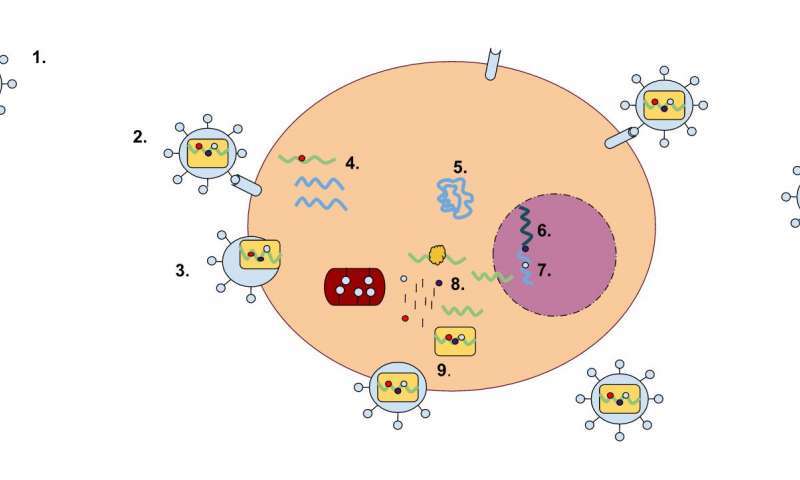 A retrovirus has a membrane containing glycoproteins, which are able to bind to a receptor protein on a host cell. There are two strands of RNA within the cell that have three enzymes: protease, reverse transcriptase, and integrase (1). The first step of replication is the binding of the glycoprotein to the receptor protein (2). Once these have been bound, the cell membrane degrades, becoming part of the host cell, and the RNA strands and enzymes enter the cell (3). Within the cell, reverse transcriptase creates a complementary strand of DNA from the retrovirus RNA and the RNA is degraded; this strand of DNA is known as cDNA (4). The cDNA is then replicated, and the two strands form a weak bond and enter the nucleus (5). Once in the nucleus, the DNA is integrated into the host cell's DNA with the help of integrase (6). This cell can either stay dormant, or RNA may be synthesized from the DNA and used to create the proteins for a new retrovirus (7). Ribosome units are used to transcribe the mRNA of the virus into the amino acid sequences which can be made into proteins in the rough endoplasmic reticulum. This step will also make viral enzymes and capsid proteins (8). Viral RNA will be made in the nucleus. These pieces are then gathered together and are pinched off of the cell membrane as a new retrovirus (9). Credit: Wikipedia/CC BY-SA 3.0
A retrovirus has a membrane containing glycoproteins, which are able to bind to a receptor protein on a host cell. There are two strands of RNA within the cell that have three enzymes: protease, reverse transcriptase, and integrase (1). The first step of replication is the binding of the glycoprotein to the receptor protein (2). Once these have been bound, the cell membrane degrades, becoming part of the host cell, and the RNA strands and enzymes enter the cell (3). Within the cell, reverse transcriptase creates a complementary strand of DNA from the retrovirus RNA and the RNA is degraded; this strand of DNA is known as cDNA (4). The cDNA is then replicated, and the two strands form a weak bond and enter the nucleus (5). Once in the nucleus, the DNA is integrated into the host cell's DNA with the help of integrase (6). This cell can either stay dormant, or RNA may be synthesized from the DNA and used to create the proteins for a new retrovirus (7). Ribosome units are used to transcribe the mRNA of the virus into the amino acid sequences which can be made into proteins in the rough endoplasmic reticulum. This step will also make viral enzymes and capsid proteins (8). Viral RNA will be made in the nucleus. These pieces are then gathered together and are pinched off of the cell membrane as a new retrovirus (9). Credit: Wikipedia/CC BY-SA 3.0
Sept. 24, 2018 (MedicalXpress) -- New research from an international team led by Oxford University's Department of Zoology and the National-Kapodistrian University of Athens, published today in Proceedings of the National Academy of Sciences (PNAS), shows that an ancient retrovirus -- HK2 -- is more frequently found in drug addicts and thus is significantly associated with addiction.
The human genome is "littered" with remnants of ancient retrovirus infections that invaded the germline of our primate ancestors. Only one of these may still be proliferating in modern humans named HERV-K HML-2 (HK2), and not all humans have the same HK2 viruses in their genomes. One specific uncommon HK2, which lies close to a gene involved in dopaminergic activity in the brain (RASGRF2), is more frequently found in drug addicts and thus is significantly associated with addiction.
The Oxford University and University of Athens research teams have shown that HK2 can manipulate nearby genes. Their study provides strong evidence that uncommon HK2 integrations can be responsible for the unappreciated pathogenic burden of addictive behaviors.
(more)
READ MORE: MedicalXpress





